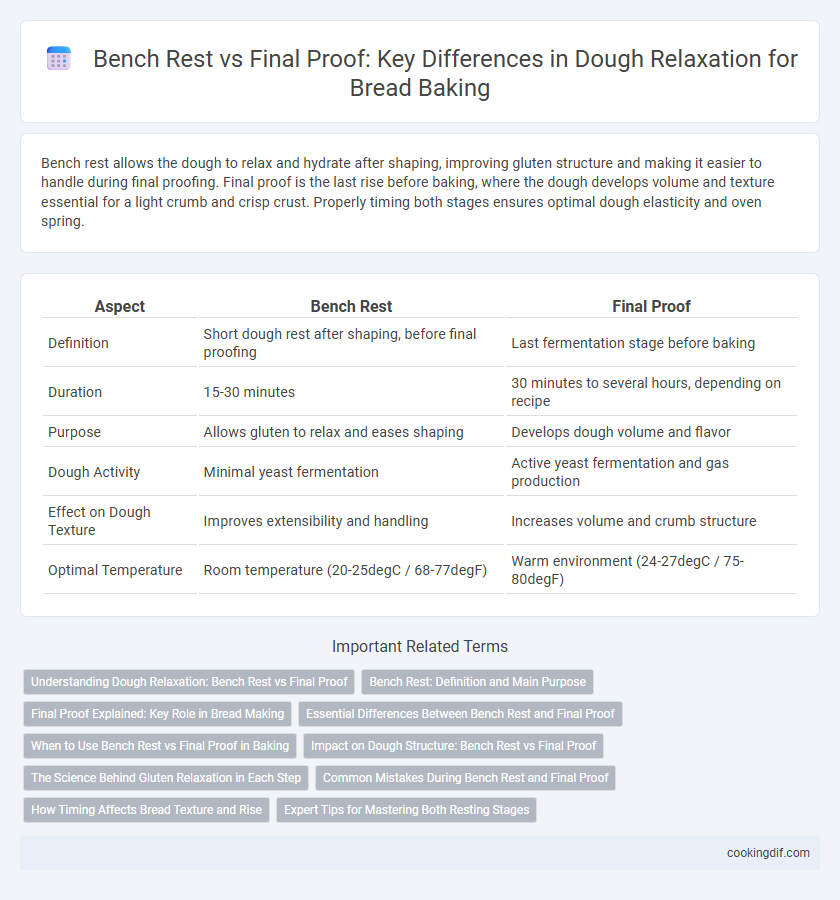Bench rest allows the dough to relax and hydrate after shaping, improving gluten structure and making it easier to handle during final proofing. Final proof is the last rise before baking, where the dough develops volume and texture essential for a light crumb and crisp crust. Properly timing both stages ensures optimal dough elasticity and oven spring.
Table of Comparison
| Aspect | Bench Rest | Final Proof |
|---|---|---|
| Definition | Short dough rest after shaping, before final proofing | Last fermentation stage before baking |
| Duration | 15-30 minutes | 30 minutes to several hours, depending on recipe |
| Purpose | Allows gluten to relax and eases shaping | Develops dough volume and flavor |
| Dough Activity | Minimal yeast fermentation | Active yeast fermentation and gas production |
| Effect on Dough Texture | Improves extensibility and handling | Increases volume and crumb structure |
| Optimal Temperature | Room temperature (20-25degC / 68-77degF) | Warm environment (24-27degC / 75-80degF) |
Understanding Dough Relaxation: Bench Rest vs Final Proof
Dough relaxation is crucial for developing gluten structure and achieving optimal bread texture, with bench rest allowing initial gluten strands to unwind after kneading, making shaping easier. Final proof occurs after shaping, enabling the dough to ferment and rise, which enhances flavor and crumb softness by allowing yeast activity and gas retention. Proper timing of both bench rest and final proof ensures balanced dough extensibility and gas retention, resulting in a well-structured, airy loaf.
Bench Rest: Definition and Main Purpose
Bench rest is a crucial resting period after initial dough mixing and shaping, allowing gluten strands to relax and hydrate evenly. This process helps reduce dough elasticity, making it easier to shape without tearing or resistance. Proper bench rest enhances dough extensibility, resulting in a better rise and improved crumb texture during baking.
Final Proof Explained: Key Role in Bread Making
Final proof is the crucial stage in bread making where the shaped dough undergoes its last rise before baking, allowing yeast fermentation to develop the dough's volume and texture. During final proof, enzymes break down starches into sugars, enhancing crust color and flavor through Maillard reactions in the oven. Proper control of temperature and humidity in final proof ensures optimal gas retention, resulting in a light, airy crumb and improved oven spring.
Essential Differences Between Bench Rest and Final Proof
Bench rest allows the dough to relax and hydrate immediately after mixing, preventing gluten strain and making shaping easier, typically lasting 15 to 30 minutes. Final proof occurs after shaping, where dough fermentation continues, enabling volume increase and flavor development, usually taking 1 to 2 hours depending on temperature. The essential difference lies in timing and purpose: bench rest is primarily for dough relaxation and easier handling, while final proof optimizes rise and crust characteristics before baking.
When to Use Bench Rest vs Final Proof in Baking
Bench rest is ideal immediately after dough mixing to allow gluten strands to relax, resulting in easier shaping and a more extensible dough. Final proof occurs after shaping and serves as the last fermentation stage, crucial for optimal volume, crumb structure, and flavor development. Use bench rest to manage dough elasticity early in the process, while final proof is essential to achieve proper rise and texture before baking.
Impact on Dough Structure: Bench Rest vs Final Proof
Bench rest allows initial gluten relaxation, improving dough extensibility and shaping ease, while final proof stabilizes gas bubbles and strengthens gluten networks for optimal volume and crumb structure. Insufficient bench rest can lead to tight dough, reducing oven spring, whereas inadequate final proof results in dense texture and poor rise. Proper timing during both phases is crucial to balance dough elasticity and fermentation for superior bread quality.
The Science Behind Gluten Relaxation in Each Step
Bench rest and final proof are critical stages for gluten relaxation in dough, influencing bread texture and volume. During bench rest, gluten strands begin to unwind and reorient, reducing dough elasticity and facilitating easier shaping. In final proof, yeast activity produces gases that expand the stretched gluten network, allowing maximum dough rise and optimal crumb structure.
Common Mistakes During Bench Rest and Final Proof
Common mistakes during bench rest include over-kneading or insufficient folding, which can inhibit proper gluten development and dough relaxation. During the final proof, neglecting temperature control or overproofing often leads to dough collapse and poor oven spring. Ensuring precise timing and monitoring dough elasticity are crucial for optimal bread texture and crumb structure.
How Timing Affects Bread Texture and Rise
Bench rest allows initial gluten relaxation and yeast activation, improving dough extensibility and early rise. Final proof, occurring after shaping, controls fermentation time to maximize gas retention for optimal crumb structure and oven spring. Managing timing between bench rest and final proof directly influences bread's texture and volume.
Expert Tips for Mastering Both Resting Stages
Bench rest and final proof are two critical dough relaxation stages that impact bread texture and rise. Expert bakers emphasize maintaining bench rest between 20 to 30 minutes to allow gluten to relax, facilitating easier shaping without tearing. Final proof duration varies by dough type but typically ranges from 1 to 2 hours, ensuring optimal yeast activity for volume and crumb development.
Bench Rest vs Final Proof for dough relaxation Infographic

 cookingdif.com
cookingdif.com